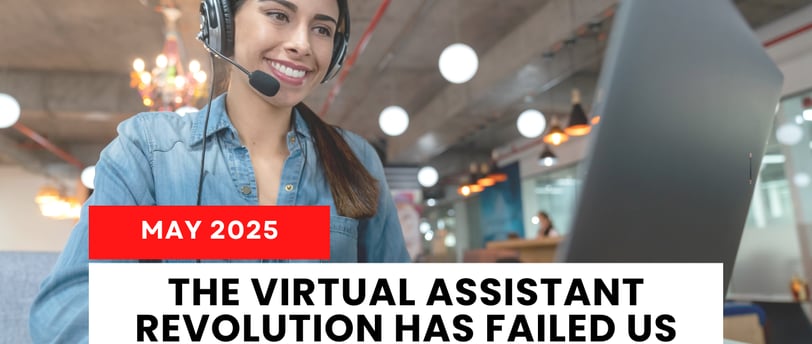THE VIRTUAL ASSISTANT REVOLUTION HAS FAILED US
The Virtual Assistant Revolution Has Failed Us dives into the harsh reality behind the hype of virtual assistance. Once hailed as the future of remote work and business efficiency, the VA industry now faces issues like exploitation, lack of proper training, miscommunication, and unrealistic expectations from both clients and agencies. This blog unpacks why the revolution didn't live up to its promise — and what needs to change for virtual assistants to truly thrive in a fair and sustainable digital workspace.
Jennifer Martinez
5/22/20255 min read


I've been watching something fascinating unfold. The virtual assistant revolution we were all promised has quietly transformed into something far more powerful. What we're witnessing isn't an evolution. It's a complete replacement.
Virtual assistants are dead. Digital business partners have taken their place.
This isn't semantic wordplay. The distinction represents a fundamental reimagining of how artificial intelligence integrates with our work. The implications for businesses that recognize this shift early will be profound.
The evidence is already emerging. By 2025, half of knowledge workers will use AI-powered digital assistants daily, compared to just 2% in 2019. This 25x increase signals something far beyond incremental adoption.
Why Virtual Assistants Failed to Deliver
Let's be honest about what traditional virtual assistants actually delivered: convenience without transformation. They answered questions, scheduled meetings, and performed basic tasks. Helpful? Absolutely. Revolutionary? Not even close.
The problem wasn't the technology itself but our limited vision for it.
We treated these systems as digital servants rather than potential partners. We asked them to perform tasks rather than solve problems. We measured their value by time saved rather than outcomes created.
The classic virtual assistant model operated within a fundamental constraint: reactivity. They waited for commands, responded to queries, and executed explicit instructions. Even with natural language processing advances, they remained fundamentally passive tools.
This reactivity created an invisible ceiling on their potential value.
The Digital Business Partner Paradigm
What makes a true business partner? They understand context. They anticipate needs. They make independent decisions. They bring unique perspectives. They challenge assumptions. They drive outcomes.
This is precisely what defines the new generation of AI systems emerging today.
Unlike traditional assistants that merely suggest actions for approval, today's AI partners use multicomponent autonomy to independently reason, decide, and problem-solve. They break free from chat-based frameworks to enable proactive decision-making.
The distinction becomes clear when we examine what these systems actually do:
Virtual Assistants react. Digital Business Partners anticipate.
Virtual Assistants execute tasks. Digital Business Partners solve problems.
Virtual Assistants provide information. Digital Business Partners deliver insights.
Virtual Assistants require explicit instructions. Digital Business Partners understand implicit context.
Virtual Assistants measure success by efficiency. Digital Business Partners measure success by outcomes.
This shift requires us to fundamentally reconsider how we integrate AI into our workflows and organizations.
The Anatomy of a Digital Business Partner
What actually differentiates these new systems? The answer lies in their architecture and capabilities.
First, they possess true contextual awareness. They don't just process individual requests in isolation. They understand the broader business environment, organizational objectives, and the implicit logic behind workflows.
Second, they demonstrate genuine agency. By 2025, agentic AI systems will transform workforce strategies by performing various functions autonomously, acting on behalf of employees while they focus on higher-value work.
Third, they integrate seamlessly across systems. Rather than operating within silos, they connect disparate tools, data sources, and platforms to create coherent workflows.
Fourth, they learn continuously. Each interaction improves their understanding of your business context, preferences, and objectives.
Fifth, they provide strategic value. They don't just save time; they actively contribute to business outcomes through data-driven insights and recommendations.
The result is a system that functions less like a tool and more like a teammate.
From Cost Center to Strategic Asset
The business implications of this shift are substantial. Virtual assistants were primarily justified through efficiency gains and cost reduction. Their ROI came from automating routine tasks and freeing human time.
Digital business partners operate under an entirely different economic model
Forward-thinking companies have moved beyond viewing AI assistants as cost-saving tools and now recognize them as strategic partners that enhance innovation, optimize operations, and deliver measurable business outcomes.
This transformation changes how we evaluate and implement these technologies:
Integration strategy shifts. Rather than bolting AI onto existing processes, organizations must redesign workflows around AI-human collaboration.
Success metrics evolve. Time saved becomes secondary to outcomes generated, insights surfaced, and opportunities identified.
Implementation approach changes. Instead of training AI to follow processes, we train it to understand business logic and objectives.
Governance models adapt. As AI systems gain autonomy, organizations need clear frameworks for oversight, accountability, and intervention
Organizations that recognize this shift early will gain significant competitive advantages.
The Human Element Remains Critical
Despite these advances, the most effective implementations maintain a crucial human element. Digital business partners don't replace human judgment; they enhance it.
The most successful deployments I've observed share a common characteristic: they maintain humans as the ultimate decision-makers while empowering AI to handle increasingly complex analytical and operational tasks
This creates a symbiotic relationship where each party contributes their unique strengths:
Humans provide creativity, ethical judgment, emotional intelligence, and contextual understanding that AI still lacks.
AI delivers computational power, pattern recognition, consistency, and tireless execution that humans struggle to match.
Together, they form partnerships more powerful than either could achieve independently.
Implementation Challenges
Transitioning from virtual assistants to digital business partners isn't without challenges. Several obstacles frequently emerge:
Data integration issues. True business partners require comprehensive access to organizational data, which often resides in disconnected systems.
Trust deficits. Granting AI systems greater autonomy requires significant trust, which builds gradually through demonstrated reliability.
Skill gaps. Working effectively with AI partners requires new skills that many organizations haven't yet developed.
Process redesign requirements. Existing workflows often need substantial redesign to fully leverage AI capabilities.
Cultural resistance. Moving from a command-based to a partnership-based AI model represents a significant cultural shift.
Organizations that proactively address these challenges position themselves to realize the full potential of digital business partners.
The Path Forward
How should forward-thinking organizations respond to this paradigm shift? I recommend a three-phase approach:
Phase 1: Reassess current AI implementations. Evaluate existing virtual assistants against partnership criteria. Are they reactive or proactive? Task-focused or outcome-oriented? Isolated or integrated?
Phase 2: Pilot partnership models. Identify high-value use cases where AI could function as a true business partner. Start small, measure outcomes, and expand based on demonstrated value.
Phase 3: Build organizational capabilities. Develop the data infrastructure, governance frameworks, and human skills needed to work effectively with digital business partners.
Throughout this process, maintain a clear focus on business outcomes rather than technological capabilities.
The Future of Work
The implications extend beyond specific AI implementations to the fundamental nature of knowledge work. As digital business partners become more capable, the boundary between human and AI responsibilities will continuously evolve.
This doesn't mean widespread job displacement. Rather, it suggests a profound shift in how humans spend their working hours.
Routine analytical tasks, information retrieval, pattern recognition, and basic decision-making will increasingly shift to AI partners. Human focus will concentrate on areas where we maintain advantages: creative problem-solving, ethical judgment, interpersonal communication, and strategic thinking.
The most successful professionals won't be those who resist this shift but those who learn to collaborate effectively with increasingly capable digital partners.
Conclusion
The virtual assistant revolution promised to transform how we work. That promise remains largely unfulfilled. Not because the technology failed, but because our vision was too limited.
The true revolution isn't about creating better digital servants. It's about developing genuine digital partners that augment human capabilities in ways we're only beginning to understand.
Organizations that recognize this distinction early and act accordingly will gain significant advantages in productivity, innovation, and competitive positioning.
The age of virtual assistants is ending. The era of digital business partners has begun.
Experts
Delivering exceptional digital marketing and assistance services.
Contact us
We can help!
helpteam@absoluteproject.org
+639295423848
© 2024. All rights reserved.
